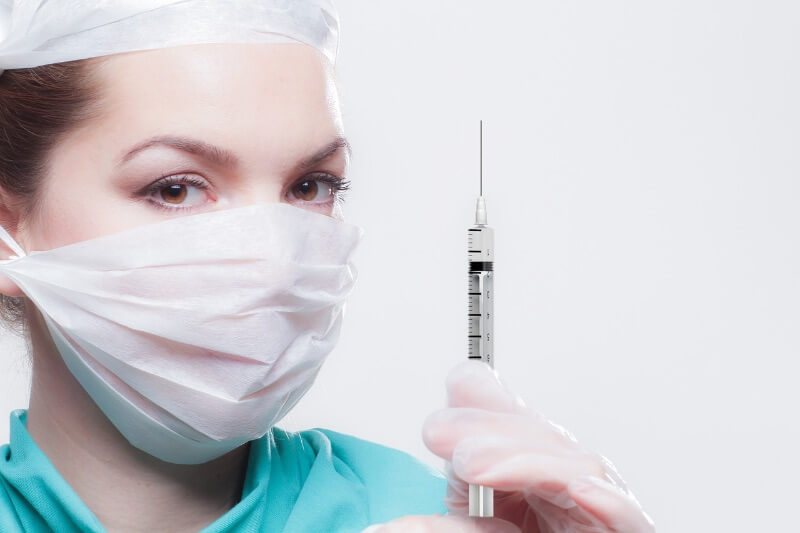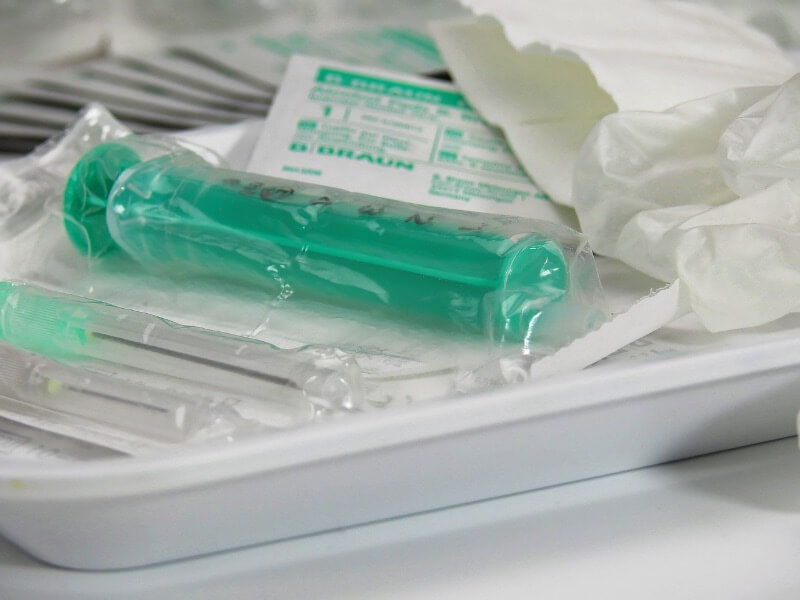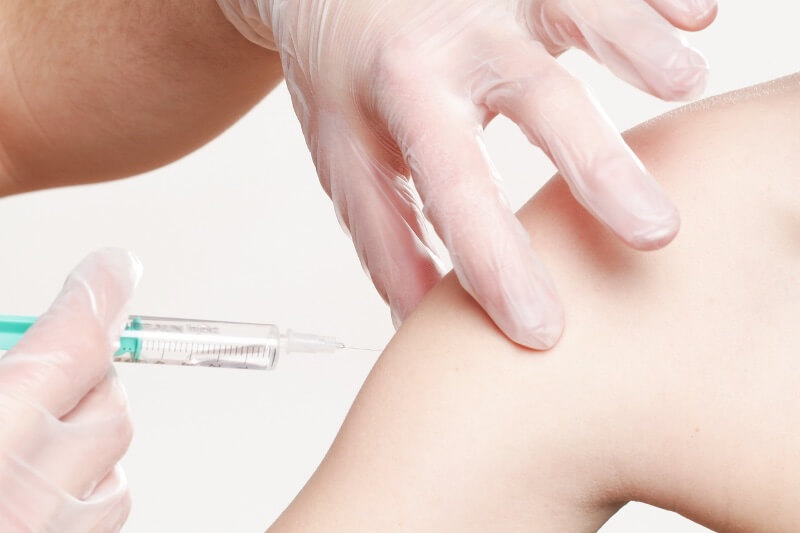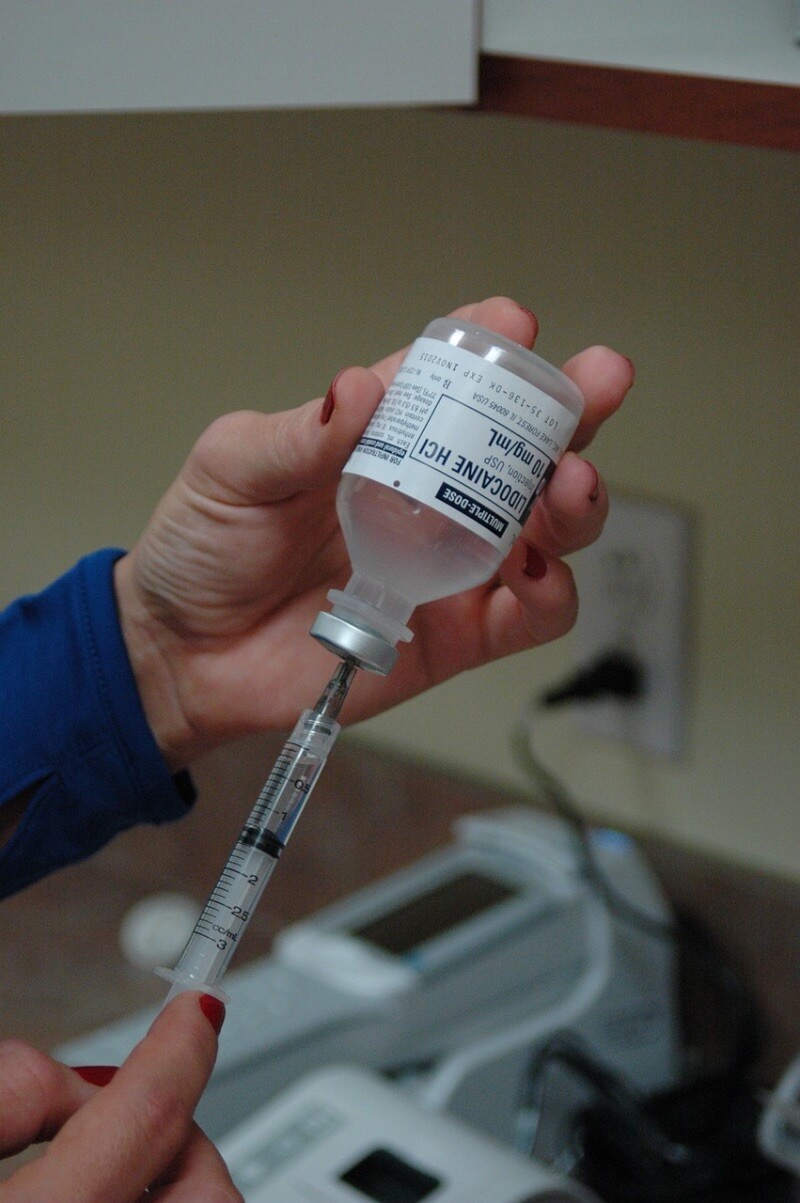Injections are an important and widely used procedure in medical practice because they allow fast and effective delivery, as well as accurate drug dosing, immunization and parenteral nutrition. There are different types of injections, including intramuscular, intravenous, subcutaneous and intradermal. Injections are administered under the supervision of medical staff to ensure proper technique and minimize risks.
What is an injection?
An injection is a medical procedure by which a liquid or medication is injected directly into the body tissue or bloodstream using a syringe and a needle, in order to achieve a therapeutic effect. Once the fluid or medication is injected into the body through the needle, it is spread in the tissues or injected directly into the bloodstream.
Injections are used for a variety of purposes, including medication administration, vaccination, blood sampling, and nutrient delivery. Injections allow the medication or substance to reach the targeted area of the body without passing through the gastrointestinal system, which is particularly important when oral intake is not possible. Additionally, injections can provide a faster and more precise therapeutic response.
Types of injections
The most common classification of injections is based on the route of administration. We distinguish injections given into the skin, subcutaneous tissue, muscle, vein, artery, abdominal cavity, or the space around the spinal cord. The choice of injection route depends on the purpose of the injection (administration of medication or blood sampling) as well as the desired speed of action (administration into a vein allows for rapid entry into the bloodstream, while subcutaneous injections enable slower absorption). It is important to note that the selection and administration of a specific medication via injections are always the responsibility of a medical professional, and the medication is used according to the diagnosis and the patient’s needs.

Skin (intradermal) injection
This type of injection is given into the superficial layer of the skin typically at a depth of 1-2 mm. The intradermal injection procedure involves injecting a small amount of medication or substance (usually less than 0.1 ml) under the surface layer of the skin, into the dermis, using a special thin needle, which is inserted at a slight angle.
It is important to administer intradermal injections carefully and precisely to ensure that the medication is properly injected into the superficial layer of the skin without penetrating deeper tissues. With intradermal injections, the medication is slowly absorbed into the bloodstream because the skin layer is relatively thin and well-vascularized. This method is used when it is necessary to assess the local reaction of the body to the medication or substance.
A common place to administer intradermal injection is the forearm region. The forearm provides good access to the surface layer of the skin, because the skin in this area is relatively thinner and has less muscle tissue compared to other parts of the body. The forearm is less sensitive compared to other parts of the body, such as the abdomen or back, which can reduce discomfort or pain during the injection of the drug. The forearm provides a convenient location for setting up and monitoring allergic tests, allowing for easier evaluation of local skin reactions.
Intradermal injections are usually given by nurses, medical technicians or doctors.
The use of intradermal injection:
- Intradermal injections are used for allergy testing. A small amount of allergen is injected under the surface layer of the skin to check the body’s reaction to a specific substance. It is commonly used in testing for allergies to food, medications, or inhalation allergens.
- Intradermal injection of Mantoux (tuberculous) test is used to detect the presence of tuberculosis. A small volume of liquid tuberculin is injected into the skin of the forearm, and the size and appearance of the local reaction are checked after 48-72 hours. This method is often used in routine testing and monitoring of tuberculosis.
- Some medications, such as local anesthetics or certain vaccines, may be administered intradermally. This method is often used to administer small doses of a drug that requires slow and gradual absorption.
Subcutaneous injection:
A subcutaneous injection is a type of injection in which medication is injected beneath the skin, into the layer located between the superficial layer of the skin and the muscles. The process of subcutaneous injection involves using a thin needle inserted beneath the skin at a slight angle. Subcutaneous injections are typically administered when a slow and gradual absorption of the medication from the subcutaneous tissue is desired, resulting in a slower absorption into the bloodstream and maintaining a prolonged therapeutic effect.
Common sites for subcutaneous injection are regions that have a higher amount of subcutaneous fat tissue, such as the abdomen, thighs (outer parts of the thighs), or the upper part of the gluteus. The front of the abdomen is one of the most common sites because it has sufficient subcutaneous fat tissue that allows for proper medication absorption. Additionally, the front of the abdomen is relatively accessible, and patients can easily self-administer subcutaneous injections in this region.
Subcutaneous injections are often suitable for self-administration, allowing patients to independently administer medications at home. This can be particularly important for chronic conditions that require regular therapy. Subcutaneous injections are usually given by nurses, medical technicians, or doctors.
Use of subcutaneous injection:
- Individuals with diabetes who require insulin replacement typically administer subcutaneous insulin injections. This type of injection allows gradual and steady absorption of insulin from the subcutaneous fat tissue, aiding in the regulation of blood sugar levels.
- Subcutaneous administration of adrenaline is commonly used in emergency cases of anaphylactic reaction, a severe allergic response that can be life-threatening. When adrenalin is administered subcutaneously, an autoinjector containing the appropriate dose of epinephrine is usually used. Individuals at known risk of anaphylaxis typically carry adrenalin autoinjectors for emergency use.
- Heparin is an anticoagulant that is often administered subcutaneously. Subcutaneous administration of heparin is usually indicated for thrombosis prophylaxis in patients who are hospitalized, have an increased risk of thromboembolism or are recovering from surgery. Heparin is administered subcutaneously in the abdominal area, usually on the surface of the skin.
- The BCG vaccine is administered subcutaneously in the shoulder region, and if needed, the MMR vaccine and hepatitis vaccine can also be given.
- Various medications can be administered subcutaneously, including hormones (insulin, HGH, GLP-1…), anticoagulants, immunomodulators, vaccines, analgesics and other drugs. Subcutaneous injections allow slower and continuous absorption of the drug, which can be useful in certain therapeutic regimens.

Intramuscular (IM) injection
Intramuscular injection is a medical procedure in which a medication is injected directly into the muscle. This type of injection allows rapid absorption of the medication into the bloodstream through the muscle, resulting in a fast and effective therapeutic effect. The process of administering an IM injection involves selecting the muscle, which depends on the type of medication and healthcare provider’s recommendation, cleaning the skin with a disinfectant, inserting the needle at an angle of approximately 90 degrees, slowly injecting the medication into the muscle to avoid discomfort or complications, and then withdrawing the needle from the muscle.
Common sites for administering intramuscular injections are the gluteus (buttock muscle) and deltoid (shoulder muscle). Both the gluteus and deltoid regions have sufficient muscle mass to accommodate larger volumes of medication. This is particularly important when larger doses of medication are required or when the medication needs to be released slowly from the muscle.
Additionally, these are deeper muscle regions compared to some other parts of the body, which can facilitate proper injection into the muscle tissue, reducing the risk of injecting into subcutaneous tissue or other structures. Compared to other body parts, the gluteus and deltoid have fewer sensitive structures such as blood vessels or nerves. This can reduce the risk of injury or discomfort during the injection.
Intramuscular injections are typically administered by nurses, medical technicians, or doctors. These healthcare professionals are trained to perform intramuscular injections correctly and have knowledge of anatomy and injection techniques into muscle tissue. In some cases, patients may also be trained to self-administer intramuscular injections at home.
The use of intramuscular injection:
- Many antibiotics can be administered intramuscularly to treat infections. These include medications such as penicillin, cephalosporin, aminoglycosides and tetracycline.
- Intramuscular injections are commonly used for pain relief and providing emergency analgesia. Examples of analgesics that can be administered intramuscularly are morphine, tramadol and diclofenac.
- Many vaccines are administered intramuscularly to stimulate the body’s immune response. Examples of vaccines administered intramuscularly include vaccines against hepatitis, influenza, diphtheria, tetanus and measles.
- In some cases, intramuscular injections are used for hormone replacement or therapy. For example, testosterone hormone therapy in men with low hormone levels or progesterone hormone therapy for certain gynecological conditions.
- In emergency medical situations, intramuscular injections can be used for the rapid administration of medications, such as adrenaline, in cases of anaphylaxis, acute allergic reactions, or cardiac arrest.
- Some antipsychotics and sedatives can be administered intramuscularly in emergency situations to quickly calm the patient. Examples include medications such as haloperidol, lorazepam and olanzapine.
- Certain vitamins, such as vitamin B12, can be administered intramuscularly to compensate for vitamin deficiency or improve absorption.
Intravenous (IV) injection
This type of injection is given directly into the vein. It allows for rapid and complete delivery of medication into the bloodstream. IV injections are often used when an immediate response to the medication is required or when maintaining a continuous infusion of drugs or fluids is necessary. The procedure for administering an IV injection involves locating a suitable vein, which may require the use of an elastic band or other method to temporarily stop the blood flow and facilitate vein identification, cleansing the skin with a disinfectant, and inserting the needle into the chosen vein at the correct angle.
In some cases, medical personnel may use special auxiliary devices, such as a needle with an attached catheter or an IV cannula, to facilitate the establishment of intravenous access. After needle insertion, it is important to check for blood flow from the needle to ensure proper positioning within the vein. The medication or fluid can then be administered. The medication can be given as a bolus injection or through an intravenous infusion.
Common sites for administering an IV injection are the veins in the arms (forearm and upper arm) and sometimes the dorsal side of the hand. These veins are relatively easily accessible and typically large enough to accommodate an IV needle. In some cases, such as emergencies or when access to arm veins is challenging, veins in the ankle joints, such as those in the feet or lower leg, can be utilized.
IV injections are typically administered by nurses, medical technicians, or doctors. They are trained in performing this type of injection correctly and have knowledge of intravenous access and the safe administration of medications through veins.
The use of intravenous injection:
- To achieve a rapid therapeutic effect, such as for the urgent relief of acute pain, treatment of acute infections, or administration of certain chemotherapy drugs.
- For rapid rehydration of a dehydrated patient or when oral fluid intake is inadequate. In this case, a solution of salts and fluids is administered intravenously (by infusion) to replenish fluid and electrolyte losses.
- Intravenous nutrition or parenteral nutrition is a method used when a patient cannot take food orally or requires additional nutrition. Nutrients, including proteins, carbohydrates, fats, vitamins, and minerals, are administered intravenously.
- For blood transfusion or administration of blood products to a patient with blood or blood component deficiencies. This may involve transfusing whole blood, red blood cells, platelets, or plasma.
- They are used to inject contrast agents used in diagnostic procedures such as CT scanning, angiography, or nuclear medicine. These contrast agents are injected intravenously to enhance visibility and the accuracy of the image.
- For blood sampling sent to the laboratory for a complete blood count analysis, blood is taken intravenously, most commonly from a vein on the inner side of the elbow.

Intra-arterial injection
Intra-arterial injection is a medical procedure in which medication or a contrast agent is directly injected into an artery. This type of injection is used in specific diagnostic or therapeutic situations.
Common sites for intraarterial injection are in the groin area where the femoral artery is located, which is a relatively large and easily accessible artery. In cardiology, the radial artery located on the inner side of the forearm along the thumb is often used for coronary angiography. Depending on the patient’s needs, the brachial artery located on the inner side of the upper arm can also be used.
Intraarterial injections are typically administered by specialists in interventional radiology or vascular surgery. These medical professionals specialize in interventional procedures involving manipulation of arteries and other blood vessels.
The use of intra-arterial injection:
- For angiography, a procedure used to visualize blood vessels. The contrast agent is injected directly into the artery, usually through a catheter, to improve the visibility of blood vessels on x-rays or other methods.
- For therapeutic purposes in a procedure known as embolization. This procedure is used to block blood vessels or tumors to restrict blood supply and reduce tumor growth. Embolization is usually performed by injecting embolic particles or a drug directly into an artery that supplies the desired vascular target.
- Intraarterial injections can also be used to target specific regional conditions or diseases. For example, intraarterial injections can be used in the treatment of tumors, arterial inflammation, or for delivering high doses of medication directly to a specific area of the body.
Lumbar injections
Lumbar injections are administered by injecting medication into the space between the vertebrae in the lumbar (lower back) region of the spinal column. These injections are often used for pain relief in the back, as well as for diagnostic purposes or for the administration of certain medications directly into the spinal canal.
Common sites for lumbar injections are the epidural and subarachnoid spaces of the spinal canal.
Specialists in anesthesiology, radiology, or neurology who perform lumbar injections have specific knowledge and skills regarding anatomical orientation, sterility, and safety when manipulating the lumbar space. They typically use fluoroscopy (moving X-ray image) or other imaging guides to accurately determine the injection site and minimize the risk of complications. It is also important for lumbar injections to be performed in an appropriate medical setting such as a hospital, clinic, or outpatient facility, where adequate support and supervision can be provided during the procedure.
The use of lumbar injection:
- Epidural injection: This injection is given into the epidural space located outside the spinal canal, but inside the spinal membrane (dure mater). It is used to relieve back pain, leg pain, as well as for anesthesia during childbirth or lower body surgery.
- Spinal injection (intrathecal injection): This injection is given into the subarachnoid space within the spinal canal, under the spinal membrane (arachnoid membrane). It is used to achieve high levels of local anesthesia, relieve pain, or administer certain medications directly into the spinal canal.
- Lumbar puncture (spinal tap): This procedure involves inserting a needle into the subarachnoid space in the lumbar (lower back) region of the spine. Its main purpose is to collect a cerebrospinal fluid (CSF) sample for diagnostic purposes, as well as to measure intracranial pressure.
- Blockage of the facial joint. This procedure involves injecting local anesthetics and/or corticosteroids directly into the facial joints, which aims to reduce inflammation, swelling and pain in the joint area.
These are just some of the types of injections used in medical practice, and there are several other specific types of injections that are administered for special purposes or in specific situations. It is important for injections to be administered under the supervision of medical personnel and in accordance with appropriate protocols and guidelines.
What are the potential complications of injections?
- There is a risk of infection at the injection site if proper aseptic technique is not followed or if the needle is contaminated. Infection can cause redness, swelling, pain, and potential spread of infection to other parts of the body.
- Formation of a hematoma, which is a collection of blood under the skin, can occur after an injection. Hematomas typically manifest as swelling, bruising, or tenderness at the injection site.
- Sometimes, there may be pain, sensitivity, or discomfort at the injection site, which can be caused by tissue damage or irritation of nerve endings.
- Some individuals may experience allergic reactions to the medications used in injections. This can include itching, rash, swelling, or more serious allergic reactions such as anaphylaxis.
- An Improper selection of the injection site can result in injury or irritation to adjacent tissues or organs.
It is important to note that these complications are relatively rare, and many can be avoided by following proper injection techniques, using sterile needles and equipment, and following the instructions of medical personnel. In case of any side effects following an injection, it is important to seek medical attention for assessment and further steps.

How to safely administer the injection?
To safely administer the injection, here are some important steps to follow:
- Preparation: Before starting the injection, hands are thoroughly washed with soap and warm water. Then all the necessary materials for injection are prepared, including a sterile needle, syringe, medicine or liquid for injection, alcohol for disinfection and bandage (if necessary).
- Cleanliness: Clean the surface on which the injection will be prepared and performed. The area of the skin where the injection with sterile alcohol or other recommended disinfectant will be disinfected.
- Preparation of needles and syringes: Remove the protective cover from the needle and carefully pull the required amount of medicine or liquid into the syringe. There should be no air bubbles in the syringe, and after that the needle cover is replaced.
- Finding the right place: The right injection point is identified. Depending on the type of injection, it can be subcutaneous tissue, muscle or vein.
- Injection technique: Holding the needle from the safe side, it is inserted quickly and decisively into the selected injection site at the appropriate angle. Do not touch the tip of the needle or the surface of the skin that has been disinfected.
- Aspiration (only with certain injections): If necessary, gently pull the plunger on the syringe back to check if the vein did not accidentally hit. If blood appears in the syringe, it means that the vein is affected, and another injection site is chosen.
- Slow injection: If necessary, slowly press the piston against the syringe to inject the drug or liquid. Pay attention to any reactions or discomfort during the injection.
- Needle removal: After injection, the needle is pulled out quickly and lightly. A sterile bandage can be placed at the injection site to stop possible bleeding.
- Material disposal: Properly discard used needles, syringes, and other materials into a special waste bin.
What injections can be administered at home?
In home conditions, certain types of injections can be administered, which are prescribed by the doctor and for which the patient is trained. This may include:
Subcutaneous injections: These are injections that are given under the skin. They are most commonly used to inject drugs such as insulin or anticoagulants. People with type 1 or type 2 diabetes often take subcutaneous insulin injections at home.
Intramuscular injections: These injections are administered into muscle tissue. They can be used to administer certain medicines that are better absorbed from muscles, as well as for vaccination. In some cases, people with certain medical conditions may be trained to self-administer intramuscular injections at home.
The doctor will give you instructions on the exact technique, dosage and disposal of the materials used. Always consult your doctor before starting any injection symphony at home on your own.
Nurses and doctors can administer subcutaneous, intramuscular and intravenous injections at home if the patient is immobile or poorly mobile, those who have chronic diseases, injuries, postoperative care, palliative care and other cases where regular and individualized medical care at home is required.
Injections are important in medical treatment because they allow precise and fast delivery of the medicine, controlled dosage, administration under the supervision of medical personnel, which allows control and safety during the administration of the drug. The injections bypass the digestive system, which allows drugs that would be broken down orally to remain stable and undisturbed as they reach the target site of action. Injections allow direct administration into the body of drugs that are not absorbed orally, ensuring their effectiveness and therapeutic effect.
Why do I need medical supervision?
It is important to note that injections should be administered only with appropriate medical training and supervision. Improper administration of injections can lead to complications or reduce the therapeutic effect of the drug. Always consult a medical professional who will provide you with the necessary information and training on the correct administration of injections according to your health needs.


